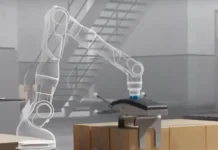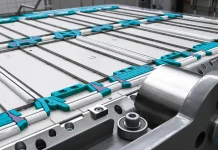by: Ken Sherman
In the United States, PVC is by far the most commonly used cover material for loose leaf ring binders. The field of Information Storage also includes the use of CDs, DVDs and other digital media. Vinyl heat-sealed binders and cases have proven popular for these products as well.
Traditionally, vinyl has been the material of choice in custom binder applications since it easily lends itself to multiple color silkscreen printing, foil stamping, embossing or debossing, appliqué, and now even digital printing.
Expanding decorating possibilities even further, cover designs are now often printed on paper and then embedded under a clear vinyl overlay. Thus, virtually any artwork can be utilized within the framework of vinyl binder manufacture. This “entrapment” binder is somewhat similar to a retail “clear-view” binder where the user simply inserts the artwork into an open end of the clear vinyl overlay. Printing on paper is faster and much less costly than elaborately decorating vinyl.
The entrapment binder is better than a clear-view binder, because all sides of the overlay are sealed shut and the artwork can be placed very close to the seal on all sides. The seal also is much tighter to the copy so that air space is eliminated and the binder has a true “custom” appearance.
Entrapment binder covers, as well as other vinyl binders with many parts to assemble, become much more labor intense. Let’s get down to cases (pun intended).
Imagine a vinyl binder with interior front and back cover pockets, with three-pieces of cover art (front cover, spine, and rear covers) and a clear overlay. To assemble this cover, a heat seal turntable must be set up to provide for placement of TEN components:
- Interior vinyl pocket
- Opaque vinyl liner
- Three chipboard pieces for front cover, spine, and rear cover
- Opaque outside vinyl cover
- Three pieces of printed cover artwork
- Clear vinyl overlay
To run such a job, setup time is considerable because each station of the turntable must be configured for each of these parts. To run the job, a constant supply of these components must be furnished to the production line. To get reasonable production output requires two or three operators. Based on information from past BIA industry surveys, three operators can produce, at best, about 1,800 units per 7 1/2 hour shift, while two people can make about 1,400 or 1,500.
So we see that this type of binder is considerably more labor-intense than a standard vinyl binder cover that has only five or six components.
| 3 PERSONS | 2 PERSONS | (1 person automated) | |
| OUTPUT | 1,800 | 1,400 | 2,700 |
| MAN HOURS | 22.5 | 15 | 7.5 |
| SETUP TIME | 90 min. | 90 min. | 40 min. |
Pick and place automation makes the most sense here. Production output can easily increase to 2,500 to 2,800 units per 7 1/2 hour shift, with only one operator needed. Let’s look at the impact this has on cost by comparing an automated production line with both a two-person and three-person non-automated production line.
The above table shows that an automated assembly line will produce 50 percent more units than a 3-person line with just 1/3 of the labor cost. Setup and changeover times are reduced by half. Note that this automated line can produce 93 percent more units than the two-person line with only half the labor cost. In both cases, setup and changeover time is reduced 56 percent.
Today, pick and place automation systems provide a cost-effective solution. Typical payback on this equipment is less than two years. The value of the labor savings is much greater than monthly lease/purchase payments, so cash flow is positive.
This same equipment also will run conventionally decorated binders with results that are superior to hand-placement of components. The secret is an optical sensor that locks in on part of the decorated design and can register on the design, rather than the perimeter of the material. The improvement in registration is astounding! This brings up another important element: ACCURACY. Pick and place machines can place a binder part to within 1/10,000ths of an inch accurately, every time. The improved quality of the final product can be easily seen. The dramatic reduction in spoilage is a further cost reduction.
Frequently Asked Questions
Q: Do I need to have a full-time “engineer” to operate and maintain the equipment?
A: No. The equipment, while sophisticated, can easily be maintained “in-house”. Most parts can be found at Grainger’s and other local industrial parts sources. Choose automation equipment from the most experienced developers. From the beginning, they will guide you through the process.
Q: The last time I checked, this kind of equipment takes up too much space and requires very large-diameter turntables. Is this still true?
A: Not at all. Use your existing turntables. Most plants already have 84″ to 96″ diameter turntables. All you add is one or two automation modules, depending on the kind of jobs you expect to run most of the time. A standard binder with 5 or 6 components requires only one module, while entrapment or clear-view binders use two.
Q: For clear-view or entrapment binders, must I buy two modules at the same time?
A: Your choice. The very fact that this equipment is MODULAR means you can add the second module at any time. The first module is generally a sheet and board feeder, so it can be used also for pre-sheeted decorated and undecorated binders. Until the second module is added, you can still make clear-view binders by using another operator to hand-feed the sheeted clear. You will still increase production speed, whether making decorated or clear-view binders, with the single module.
Q: I was under the impression that this equipment costs around $1,000,000 for each assembly line. We are just a medium-sized manufacturer and cannot justify that.
A: The kind of automation modules we are discussing here cost but a small fraction of that. As we’ve mentioned, the equipment will produce a positive cash flow and most likely pay for itself in less than two years.
Q: I had heard that automation is great, but only if you set it up once and run the same product “forever” because setup and change overs are so time and labor-consuming.
A: There are certainly machines on the market that fit that description but the modules we are describing can be set up and changed over in between one half hour and one hour. Far fewer fixtures are needed at each turntable station and that is what consumes time and labor when setting up or changing over. Programming each module is simple. A laser scanner “sees” the turntable setup and “learns” where each binder component must be placed. After that, repeatable accuracy produces consistent, quality covers every time.
Q: Can the modules roll-feed from pre-slit vinyl rolls?
A: Yes, modules can be built to feed either vinyl sheets or slit rolls. In the case of clear overlays, as in clear-view or entrapment binders, roll-feeding the clear is best. The module feeds the proper length of vinyl from the roll, cuts the sheet and then places it into position. Undecorated opaque vinyl also lends itself to roll-feeding. If you are slitting and sheeting your vinyl, such as for decorated covers, sheet feeding is ideal.
Q: What does the one operator do in a full entrapment job?
A: As we’ve said, a complete entrapment needs only one operator. This person removes the finished cover, then inspects and strips the “ribbon”. The operator then places (for example) the inside pocket and liner. The modules do the rest.
Q: Must the machine be stopped to load vinyl or board?
A: In the case of modules that are feeding sheet vinyl and board or entrapment-printed sheets, the machine can be loaded while continuously running due to double-width hoppers. If the module is built to roll-feed the vinyl, changing rolls would need a brief stop of 30 seconds to 60 seconds.
Q: What brands of automation modules are being used most in the United States?
A: This type of equipment was first developed specifically for our industry by Douglas Lee of Lee Manufacturing in Ste. Genevieve, Mo. There is more of their equipment in use in the U.S. than any other kind dealing specifically with the custom industry. Each module is designed and built-to-order. Automation is not a “one size fits all” affair. Each individual situation is looked at, analyzed, and the best automation solutions are then presented.
Ken Sherman is the president and CEO of Charles Leonard Western, Inc., the leading supplier of metals and devices in the Western United States. Sherman has been in the industry for over 40 years. He has been a frequent speaker/panelist at BIA Conventions and also has authored numerous articles for trade publications.




